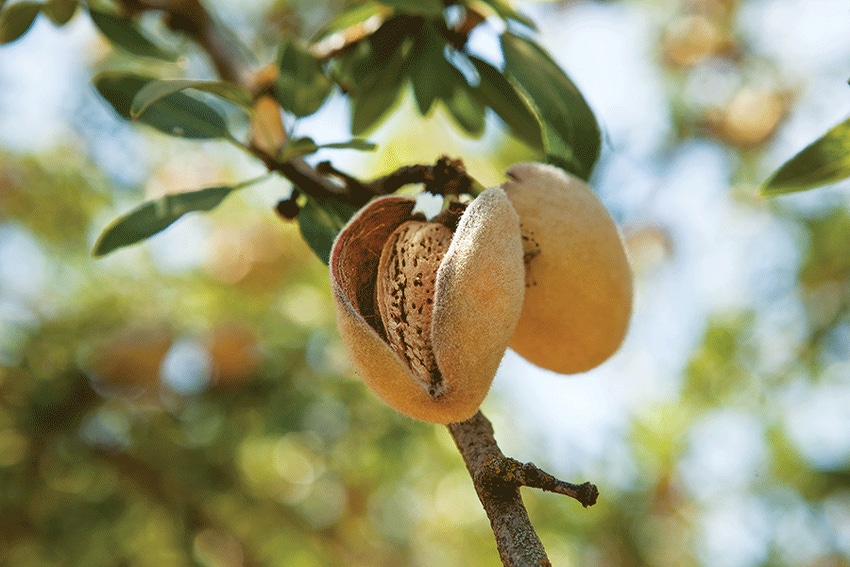April 16, 2018

Decades of research investigating methods for reducing aflatoxin contamination have led to the discovery of the atoxigenic Aspergillus strain, referred to as AF36.
Aflatoxin contamination, which is particularly associated with navel orangeworm (NOW) damage, may result in significant monetary losses when detected in almonds destined for market, and may pose a potential food safety risk.
Classified as a carcinogen, aflatoxin thresholds have been established by many countries. The European Union is one of the largest markets for California Almonds, and has one of the lowest tolerances of 10 ppb (parts-per-billion). When shipments exceed thresholds, the consignments are rejected and must either be reconditioned or destroyed.
However, research suggests that applying the recently registered for almonds biocontrol agent, AF36 Prevail, to orchards this season may help to significantly reduce aflatoxin levels.
EFFECTIVE BIOCONTROL
Aflatoxins are naturally-occurring “toxigenic” mold strains produced by certain strains of Aspergillus molds. AF36 is also an Aspergillus mold, but this naturally-occurring strain does not produce aflatoxin, and therefore is “atoxigenic.”
AF36 is carried on a sterilized sorghum seed and is found in the soil of fig, pistachio, and almond orchards. When applied, this atoxigenic strain out-competes and displaces existing toxigenic mold strains in the orchard floor and the tree canopy, and acts as a biological control to reduce the potential for aflatoxin.
AF36 was first introduced to Arizona cotton fields in 1996, and has since been registered for other crops. In 2012, AF36 Prevail was registered in pistachios, and over the last four years field experience in pistachios and research studies in almonds show that AF36-treated orchards are less likely to be contaminated by aflatoxins.
In 2017, pistachio growers treated approximately 200,000 acres with AF36 and the Environmental Protection Agency and California Department of Pesticide Regulation approved its use in almond orchards.
For almonds, this work has been led by Dr. Themis Michailides at the UC Kearney Agricultural Research and Extension Center, Parlier, and funded over the long term by Almond Board of California.
45 PERCENT REDUCTIONS
Dr. Michailides has devoted decades to studying aflatoxins, and his work has been instrumental in development and registration of AF36 in several crops.1 Until now, he notes, tree nut growers had no direct way to combat aflatoxin. Instead contamination has been managed primarily through preventing navel orangeworm damage.
As noted below, effective orangeworm management is still critical; however, AF36 offers an additional tool that has a direct impact on reducing harmful toxigenic Aspergillus mold strains and the aflatoxin they produce.
Field studies in both pistachios and almonds have been impressive. In a study of commercial pistachio orchards with AF36 applications occurring once per year from 2009–2011, Michailides and team observed aflatoxin reductions from 20 percent to 45 percent, with a 40 percent total reduction at the end of the study.
Once Michailides obtained an experimental use permit for pistachios, his team used AF36 to treat 3,000 acres of pistachio orchards. “We found aflatoxin reductions of up to 45 percent in those crop samples,” he says. Displacement rates in the soil reached 90 percent to 95 percent.
The expectation is that when both pistachios and almonds are treated on an area-wide basis, aflatoxin reduction will even be greater.
PROPER APPLICATION
Michailides notes four application factors that are particularly critical to successful outcomes with AF36 application: timing, amount, placement, and proper irrigation.
Timing: In experimental use on almonds, AF36 proved most effective when spread on moist soil in early July. Ultimately though, application should be timed around hullsplit. If you know when to expect hullsplit, you should plan to apply about one to two weeks before. You want to have maximum sporulation of the biocontrol during the hullsplit stage.
Amount: The proper application rate is 10 pounds per acre.
Placement: AF36 should be applied within the berm area of the orchard, not in row middles, so it will be reached by the irrigation system.
Proper Irrigation: Irrigation is required directly after application. The AF36 product will not sporulate without moisture, and can fail if there is too much moisture. Aim for soil moisture levels around 13 percent to 18 percent. Proper placement within the berm, close to the irrigation system, will ensure it is successfully activated.
NOW MANAGEMENT PARAMOUNT
While the AF36 Prevail product shows promise, it is essential to keep up with NOW and pest management, as NOW damage still presents one of the greatest threats to aflatoxin development2 in the crop.
Growers can minimize the risk of aflatoxin contamination by using multiple IPM practices: reducing overwintering populations of NOW through winter sanitation; timely harvest; in-season sprays; and employing mating disruption.
To learn more about AF36 and its application, you can watch two short videos produced by California Pistachios (https://bit.ly/2IveR0f). While the videos feature AF36 in pistachio orchards, the information is useful and accurate for almond growers as well.
Western Milling is the distributor for AF36 Prevail in California. For product information, growers can contact Jeff Chedester, seed business manager, at (559) 978-0725.
--------
1Doster, M.A., Cotty, P.J., and Michailides, T.J. 2014. Evaluation of the atoxigenic Aspergillus flavus strain AF36 in pistachio orchards. Plant Disease 98:948-956.
2 Palumbo, J.D., Mahoney, N.E., Light, D.M., Siegel, J., Puckett, R.D., Michailides, T. J. 2014. Spread of Aspergillus flavus by navel orangeworm (Amyelois transitella) on almond. Plant Disease 98:1194-1199.
You May Also Like




